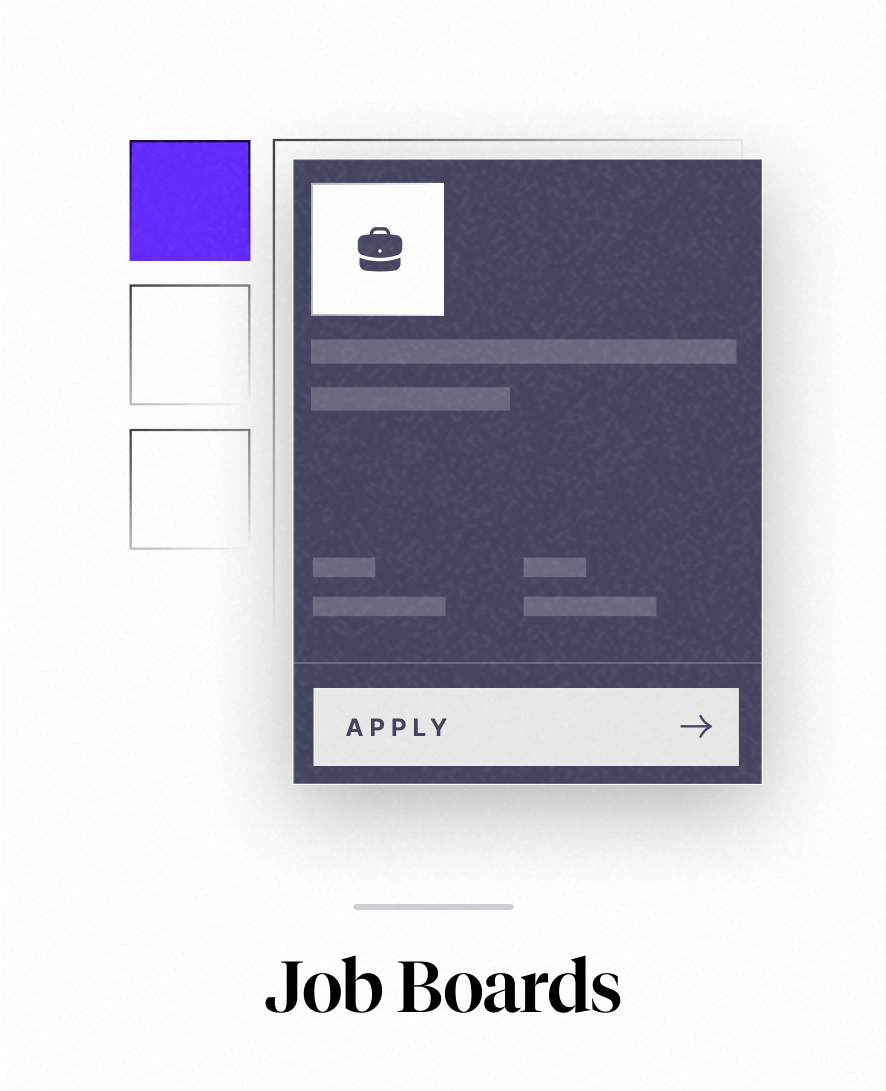MasterChow
Brand Led Growth
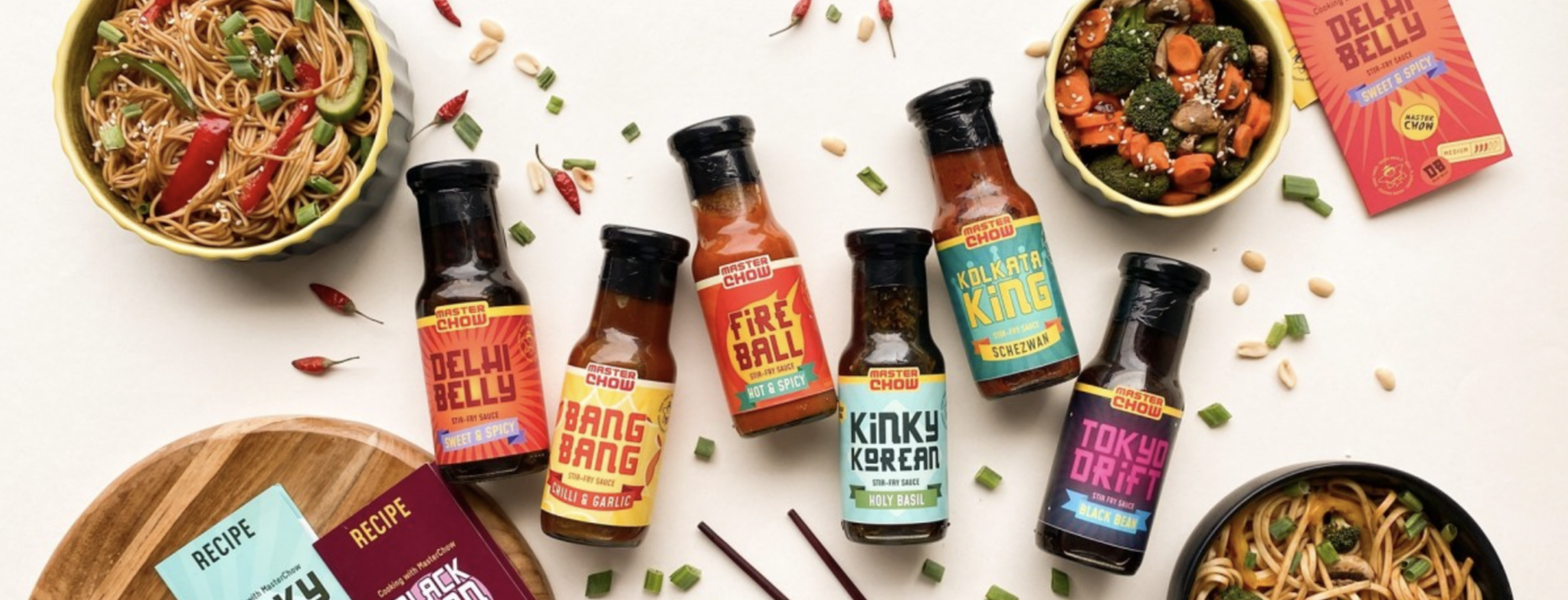
Overview
MasterChow is a flavor-packed passion project to bring restaurant-style Asian food into the comfort of consumers' homes, with a focus on making home cooking easy, convenient and delicious!
It is a mass-premium brand operating in the ready-to-cook segment. Founded in 2020, the brand offers a range of premium Asian pantry staples like stir-fry sauces, ready-to-eat dips and noodles—for quick, restaurant-style food at home. The range of sauces are signature recipes developed in-house at their manufacturing facility. Made with 100% natural ingredients, their products are crafted fresh in small batches and free of artificial additives. They focus on the D2C model, delivering across India via their own digital store and major marketplaces like Amazon, Blinkit, etc.
Section 1: Crafting the Core Value Prop
Understanding the product
Background
During the COVID-19 lockdowns, with delivery services halted and options to dine out cut off, customers of Wok Me—a popular Asian QSR in Delhi known for its distinctive and flavorful dishes—found themselves craving their favorite meals. Struck by a mix of frustration and longing for the unique tastes of Wok Me, they reached out to the founders, Vidur and Sidhanth. The customers made a heartfelt plea for batches of the restaurant's signature sauces, hoping to recreate the beloved dishes in their own kitchens while the restaurant was shuttered. It was from these earnest requests that the idea for MasterChow took root—a brand that would bring the essence of Wok Me’s flavors into the comfort of home cooking.
Seven years before the pandemic, inspired by their travels and craving for the authentic Asian flavors they couldn't easily find in India, Vidur and Sidhanth had set out to create Wok Me—a restaurant they hoped to grow into a chain of 100+ outlets. The restaurant was designed to delight the sophisticated tastes of worldly Indians, striking a harmonious blend of authentic international tastes with local culinary preference; bridging the gap between the offerings of India’s street chinese hawkers & expensive gourmet asian restaurants.
So, when the concept of MasterChow emerged, it was a clear, strategic pivot for them. They saw MasterChow as a vehicle to scale their dream—not through physical outlets, which was daunting, but by bottling and selling the essence of Wok Me's flavors. This approach promised a faster and more efficient way to grow their business and reach a wider audience.
— - — - —
Diving into this background was essential to develop a fundamental understanding of who MasterChow truly is, how it came to be & what it aspires to solve for.
Main Offering
- A wide range of ready-to-cook Asian food products like stir fry sauces, dips, noodles, rice, & meal kits;
- made with 100% natural ingredients, crafted fresh in small batches, & free of artificial additives;
- in innovative flavors tailored to the modern-Indian palate;
- priced in a way that makes them accessible while reflecting their premium quality;
- offering a restaurant-style experience at home.
Customer Pain Relievers
- Convenience: MasterChow products reduce meal preparation time and complexity, making it possible to enjoy Asian cuisine at home without extensive cooking or the hassle of sourcing ingredients.
- Authentic Taste: By offering genuine flavors developed through in-house recipes, MasterChow allows customers to experience restaurant-quality meals.
- Health Conscious: With 100% natural ingredients and no artificial additives, MasterChow provides a healthier alternative to other ready-to-cook options in the market.
- Variety: The range of sauces and noodles caters to various taste preferences, offering versatility in cooking.
Understanding the product in detail
1. What is MasterChow really in the business for?
- MasterChow is all about simplifying Asian cooking, while maintaining a high standard of authenticity and taste. They offer a convenient way for food enthusiasts and home cooks to enjoy restaurant-style Asian dishes at home without the need for extensive cooking experience or time investment, in an accessible and easy-to-prepare format.
- MasterChow's mission is to bring quality ready-to-cook Asian cuisine to every Indian household, addressing the lack of innovation and clean label products in this space.
- MasterChow wants to empower & give confidence to home cooks that they can create the best asian dishes at home, curated to their taste; saying—Yes, you can absolutely do it!
2. What problem does MasterChow solve?
- MasterChow addresses the need for quick and easy preparation of authentic Asian meals at home.
- It solves the problems of
- time-consuming cooking processes
- the complexity of Asian recipes
- the difficulty in sourcing authentic ingredients
- curating a balance between authentic asian flavours & the modern-Indian palate - The brand also addresses the gap in the market for high-quality, natural, and preservative-free Asian cooking essentials.
3. What are some customer benefits?
Customers benefit from MasterChow's range of products by having:
- Ease of Use: The ability to cook complex Asian dishes easily at home, without requiring extensive cooking expertise.
- Quick recipes: Preparing entire dishes in a span of 10 to 30 minutes.
- Authenticity: Enjoying restaurant-style Asian food with authentic flavors, without artificial additives.
- Convenience: Access to a wide variety of Asian flavors without the hassle of sourcing ingredients or following complicated recipes.
- Health: Healthier meal options with products made from 100% natural ingredients, no preservatives, & cooked fresh at home.
4. How is the user currently solving this problem?
Prior to MasterChow, users typically relied on:
- Existing ready-to-cook options that often contain preservatives and lack authentic flavors.
- Takeout from restaurants, which can be extremely expensive and inconsistent, & do not cater to the modern-Indian palate.
- Buying from street hawkers, which could be unhealthy/unsanitary & lack authentic flavors.
- Cooking from scratch, which requires time, effort, and a level of culinary skill that many busy individuals may not have.
Defining JTBD of the Brand
Competitive Landscape
Within the ready-to-cook asian cuisine market in India, key-competitors of MasterChow include brands like Chings, Veeba, Chef Boss (closed now), Lee Kum Kee, Ong’s, etc.
Comparative deep-dive into some competitors:
Brands | Product Offerings | Strengths | Weaknesses | Pricing |
MasterChow | a range of premium Asian pantry staples like stir-fry sauces, ready-to-eat dips, noodles, rice, & meal-kits | - focus on authentic Asian flavors - use of 100% natural ingredients - offering innovative products tailored to the Indian palate | relative newcomer in the market, lacks the brand recognition of more established competitors | positioned as a mass-premium brand, balancing affordability with perceived high quality |
Chings | wide range of Chinese food products, including instant noodles, sauces, and meal kits | - strong brand recognition - extensive product range - affordability | lacks focus on authentic Asian flavors, perceived as more Indianized | generally targets the mass market with competitive pricing |
Veeba | variety of sauces and dips, including Asian flavors, with a focus on health-conscious products | - strong presence in the health-conscious segment - offering vegan and low-calorie options | limited range in authentic Asian cuisine | positioned in the mid-range, catering to health-conscious consumers |
Lee Kum Kee | authentic Chinese sauces and condiments | - authentic traditional Asian flavors - international brand recognition | higher price point, less tailored to Indian tastes | premium pricing, targeting consumers seeking authentic experiences |
Ong’s | range of Asian sauces and pastes | - variety in traditional Asian flavors | lesser brand recognition in India, does not cater specifically to Indian preferences | generally premium, targeting a niche market |
Comparative Analysis:
- Market Positioning: MasterChow’s mass-premium positioning (aiming to bridge the gap between low-cost, mass-market products and high-end, gourmet offerings) allows it to compete on both quality (with brands like Lee Kum Kee and Ong's) and price (with brands like Chings and Veeba).
- Target Audience: Catering to a generation that values both convenience and authenticity in their culinary experiences, MasterChow's product offerings are aligned with contemporary consumer trends. They offer an optimal balance between authentic asian flavours & the modern-Indian palate.
- Product Range and Innovation: While competitors like Chings and Veeba also offer a wide range of products, MasterChow differentiates itself through its unique and innovative flavors tailored to the Indian palate. Their focus on quality and natural ingredients sets them apart from others.
- Price Point and Accessibility: Competing with both local and international brands, MasterChow maintains a balance between quality and affordability, making it accessible to a broader market compared to premium imported brands.
- Digital Presence: MasterChow's strong digital and e-commerce presence gives it an edge over traditional brands that rely more on offline retail channels. This online focus aligns well with the growing trend of online shopping, especially among younger/tech-savvy consumers.
Product Category
MasterChow is a NEW ENTRANT in an EXISTING CATEGORY. Here’s why:
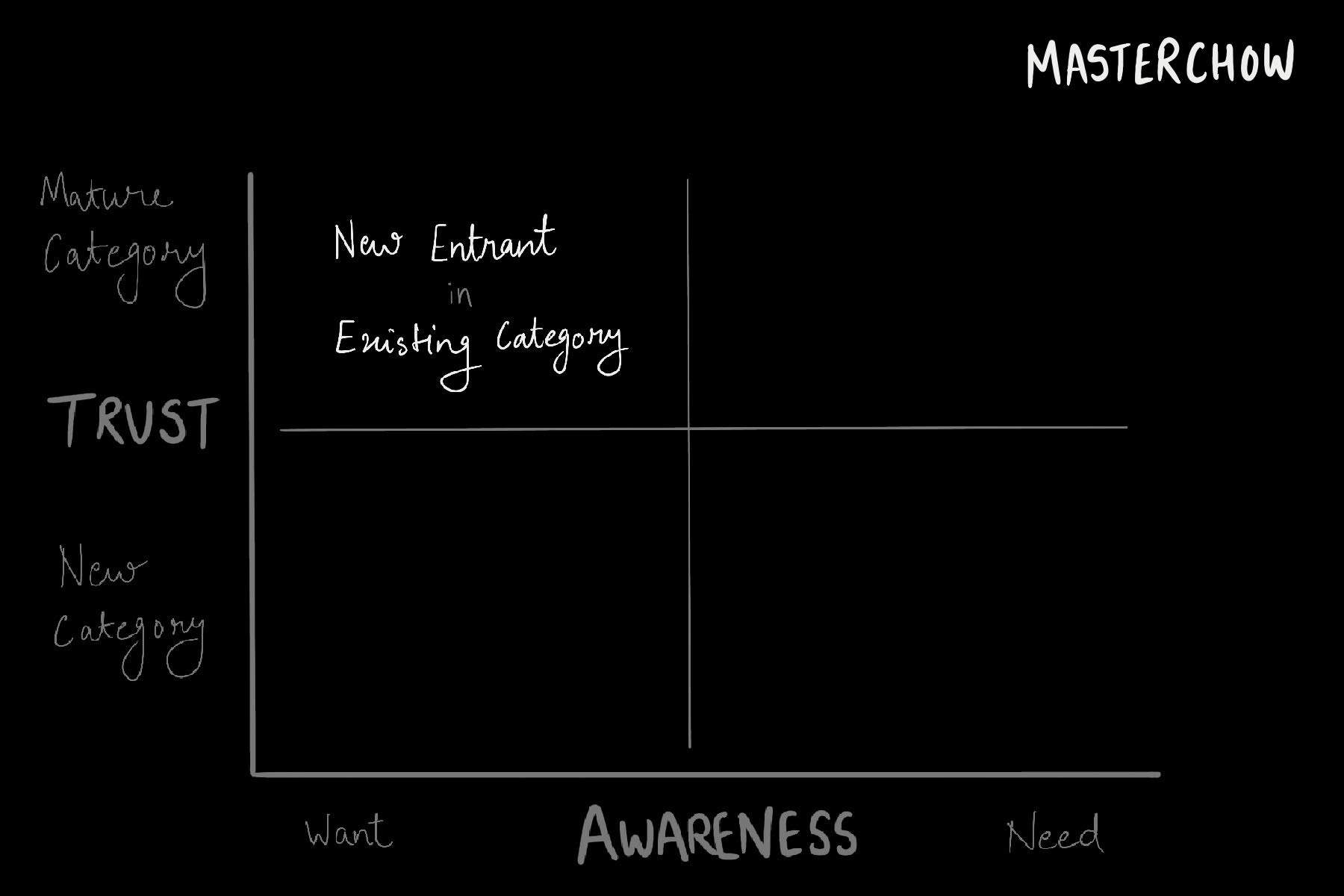
- Existing Market Presence: Asian cuisine, and more broadly, ready-to-cook meal segments, have been established markets in India. MasterChow entered into this space with a unique proposition, but it operates within the pre-existing framework of at-home cooking solutions, which includes a variety of brands offering Asian and other cuisine meal kits and ready-to-cook products.
- Brand Differentiation: While MasterChow has differentiated itself through its authentic and premium product offerings tailored to the Indian palate, it competes with other brands such as Chings & Veeba, as well as imported brands like Lee Kum Kee and Ong's. This competition within a well-defined market segment suggests that MasterChow is enhancing and innovating within an existing category rather than creating a new one.
- Consumer Awareness: The ready-to-cook category is already familiar to Indian consumers, which means that MasterChow is not creating awareness of a new category but is instead positioning itself as a brand within a known market. Their approach seems to focus on differentiating their offerings based on quality, taste, and convenience rather than educating consumers about a completely new type of product or service.
Thus, MasterChow is not a Category Creator like Netflix was upon its entry to India, where it had to introduce a new way of consuming media content. Instead, MasterChow is more akin to Even Healthcare, which entered into the existing healthcare services category but with a new product offering.
MasterChow's strategy appears to be focused on capturing market share in the ready-to-cook segment by offering high-quality, convenient solutions that appeal to the evolving tastes and preferences of Indian consumers, particularly those looking for a blend of authenticity and ease-of-use in their cooking experiences.
Brand JTBD
MasterChow’s brand JTBD, to transition from a New Entrant to a Category Leader, is to focus on DIFFERENTIATION, PREFERENCE & TRUST. Here’s why:
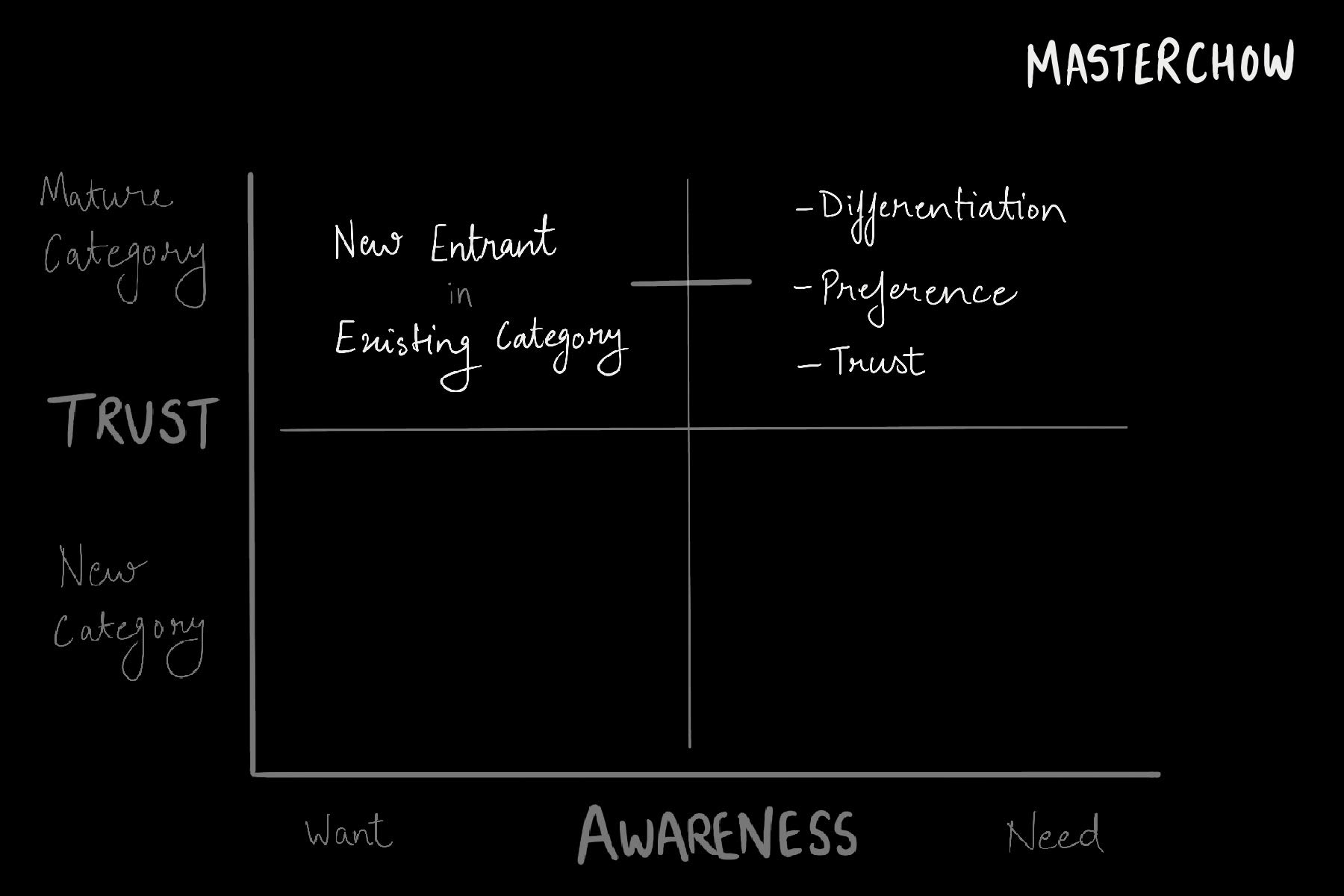
- Differentiation: Captures Interest
In a competitive market, differentiation is crucial for a brand to stand out. For MasterChow, which operates in the crowded ready-to-cook Asian food category, it’s imperative to differentiate from other brands that consumers already recognize. By highlighting unique aspects of their products, such as authentic flavors tailored for the Indian palate or healthier, natural ingredients, MasterChow can capture the attention of potential customers. Differentiation is not just about being different; it's about being better and more relevant to the consumer's needs, which in turn drives market share and brand growth. - Preference: Boosts Sales
Preference is about being the chosen solution for a customer’s job; developing a customer preference is about building a loyal customer base that consistently chooses your brand over competitors. For MasterChow, creating a strong preference means customers will not only try their products but will continue to choose them for future purchases. This involves not just meeting but exceeding customer expectations with exceptional flavors and experiences. Preference leads to repeat purchases, word-of-mouth referrals, and can ultimately turn casual buyers into brand advocates. It is the preference that drives sales volume and helps a new brand like MasterChow gain a foothold in the market. - Trust: Cements a long-term consumer relationship
Trust is the foundation of any strong brand relationship, especially for food products where quality and safety are paramount. As a new entrant, MasterChow must establish trust with consumers to assure them of the reliability, quality, and safety of their products. Trust leads to brand credibility, which is essential for sustained long-term growth. When consumers trust a brand, they are more likely to try new products it introduces and remain loyal even in the face of competition. For MasterChow, building trust will be key to moving from a new entrant to a category leader, as it directly impacts customer retention and market reputation.
These are critical for securing a competitive advantage. Excelling in these areas can help MasterChow not only establish itself in the market but also set the stage for becoming a category leader. These qualities directly influence a brand’s ability to attract and retain customers, which is vital for MasterChow's growth trajectory within the existing category.
Understanding the User
Primary ICP
Overview: Digital-savvy, health-conscious individuals who value both the convenience and the cultural experience of cooking and eating. They likely reside in urban areas where access to diverse food options is valued, but the convenience of home cooking is essential.
Demographics: | |
Age | 24-35 |
Gender | All |
Location | Urban areas, particularly Tier 1 & 2 cities |
Salary | Middle to upper-middle-class, with disposable incomes |
Employment | Working professionals who are time-poor and seek quick cooking solutions |
Social Media | Primarily Instagram users |
Apps | Swiggy, Zomato, Uber, Ola, Amazon, Myntra, Ajio, Gpay, CRED, Blinkit, Netflix, APV, Hotstar |
Marital Status | Both singles and married individuals |
Children | Less-likely |
New to City | Possibly, creating a need to cater to self’s food requirements |
Behaviours & Preferences: | |
Food Preferences | Enjoy Asian cuisine and are adventurous with food choices; may have a preference for spicy or exotic flavors |
Cooking Habits | Interested in cooking and likely to try new recipes, especially those that can be prepared quickly and easily |
Lifestyle | Lead a fast-paced lifestyle but do not want to compromise on the quality of their meals |
Health Consciousness | Likely health-conscious and prefer natural products without artificial additives |
Cultural Interests | Appreciation for diverse cultures |
Media Consumption | watch travel and cooking shows, follow food blogs, and are inspired by culinary influencers, enjoy K-dramas |
Influencers followed | Potential followers of celebrity chefs or food influencers like Sarah Todd, Gordon Ramsay |
Behaviour | Engaged in online shopping, values convenience, and likely to seek out quality products with good reviews |
Time Spent | Several hours on Instagram, watching OTT content, working, commuting, attending events (both professional, like networking events & seminars, as well as cultural, such as music festivals, flea markets) |
Value | Willing to pay a premium for convenience + high-quality, authentic experiences |
Other qualities:
Technology Savvy: They are likely adept with technology, not just in terms of social media, but also comfortable with e-commerce, online payments, and the use of cooking-related apps for recipes or meal planning.
Experience Seekers: These individuals probably seek more than just food; they seek an experience that comes with cooking and enjoying a meal. This could be the joy of recreating a favorite dish from a restaurant or the novelty of trying a new cuisine.
Community-Oriented: They may enjoy sharing their culinary experiences with others, whether that's hosting dinners, posting their creations on social media, or engaging with online communities of fellow food enthusiasts.
Brand Conscious: They might be brand-conscious consumers who look for premium brands that also align with their personal values around quality, sustainability, and company ethos.
Taste Explorers: Given the unique flavors offered by MasterChow, such as Korean BBQ Sauce and Sichuan Chilli Oil, the target customers are likely explorers of taste who enjoy global cuisines and are always on the lookout for the next unique flavor to try.
User Insights
- Category Perception: Consumers perceive the ready-to-cook Asian cuisine category as a convenient solution that fits their fast-paced lifestyles. However, they are increasingly concerned about the taste, healthiness, & quality of these products, and brands that can cater to these aspects while providing convenience are likely to be favored.
- Value: They value convenience, taste, quality, authenticity, variety.
- Problems: Time-consuming cooking processes, the complexity of Asian recipes, the difficulty in sourcing authentic ingredients, curating a balance between authentic asian flavours & the modern-Indian palate.
- Non-negotiables: Convenience, ease-of-use, Natural ingredients, no artificial additives, the authenticity of flavor profiles.
- Negotiables: They may compromise on price points for higher quality and unique flavor experiences.
- Aspirations: To become more skilled in cooking, to explore and enjoy international cuisines, and to lead a lifestyle that balances health & money with gourmet experiences.
- Goals:
Social: Impress friends and family with culinary skills and the ability to serve restaurant-quality Asian meals at home.
Functional: Convenience. Organize and simplify meal preparation without losing the essence of authentic asian flavors.
Personal: Gain control over dietary habits by eating healthier without giving up on diverse and rich flavors.
Financial: Obtain value for money by investing in premium products that deliver on their promises. - Primary Goal - Functional: Convenience. Organize and simplify meal preparation without losing the essence of authentic asian flavors.
Articulating the Core Value Prop
Core Value Prop
For the mobile first generation
Who crave authentic, restaurant-style Asian food at home
MasterChow is a ready-to-cook Asian cuisine brand
That delivers an effortless culinary experience in the comfort of your kitchen—authentic taste, 100% natural ingredients, and vibrant flavors; all ready in minutes.
Variation (archive)
For the mobile first generation
Who crave authentic, restaurant-style Asian food at home
MasterChow is a ready-to-cook Asian cuisine brand
That delivers vibrant, authentic Asian flavors to your kitchen, effortlessly—without the need for complex cooking skills or obscure ingredients for time-consuming recipes.
Section 2: Finding the Brand Wedge
Core Insights
Category Insights
- The ready-to-cook Asian cuisine category is crowded with products that often compromise on either taste or healthiness, and not offering enough variety to meet their sophisticated palates.
- Consumers are looking for quick and easy solutions that do not sacrifice the authentic flavors they love.
User Problems
- Users find cooking Asian cuisine at home time-consuming, the recipes complex, & the ingredients hard to source.
- They struggle to find ready-to-cook options that are both healthy and authentically flavored.
User Non-negotiables
- Authentic taste that matches their favorite Asian restaurants.
- Products must be easy to prepare, aligning with the fast-paced lifestyles of urban consumers.
- Healthy options with natural ingredients and no preservatives.
User Negotiables
- While variety is desired, users may be willing to start with a limited range and expand their palate gradually.
- Price, provided it reflects the quality and authenticity of the experience.
User Aspirations
- Users aspire to effortlessly create and enjoy gourmet Asian dining experiences in their homes.
- They want to enjoy a variety of Asian flavors that are not only tasty, but also high quality & healthy.
- They seek to impress friends and family with their cooking skills, showcasing a cosmopolitan lifestyle.
Defining Brand Wedge
If the ready-to-cook Asian cuisine category perception is that
it lacks authentic flavors & healthiness
and my user feels
challenged by the time and complexity of preparing flavorful Asian meals at home
then MasterChow will always prioritize delivering authentic asian meals, with easy & fast preparation, ensuring 100% natural ingredients.
Building Brand Footprint
How will the brand LOOK
"I am vibrant and contemporary,
but I am not overwhelming.”
MasterChow’s brand aesthetic will be a fusion of modernity with touches of traditional Asian motifs, reflecting the marriage of convenience and authenticity.
- Logo: The logo will be simple yet bold, using clean lines & vibrant colors that are reminiscent of Asian spices and flavors. It would include an element that hints at authentic Asian influences without being cliché, ensuring recognizability without being too busy or intricate.
- Typography: The brand's typography on packaging and marketing would be clean and modern, for readability and a contemporary feel. It will reflect this balance, perhaps through the use of bold headings combined with simple, clean text for descriptions, ensuring the message is not lost in design.
- Colors: The colors (RED & YELLOW) will be a balance between warm, earthy tones and pops of color to represent the variety of flavors and spices. However, the use of these colors would be balanced and not too saturated, avoiding a chaotic or excessively loud appearance.
- Illustrations: The illustrations and photography would be fresh and dynamic, possibly using fluid lines or abstract shapes to convey movement and energy associated with contemporary art. They would not be overly complex or detailed, maintaining a clean and uncluttered look, highlighting the simplicity of creating the meal, with a focus on the end product in a homely setting.
- Materials & Textures: The materials for packaging would be modern, like matte finishes that feel good to the touch and visually indicate a premium quality, while the textures would be subtle, not distracting from the overall design.
- Iconography: Icons used will be minimalistic, using symbols that are quickly identifiable with cooking and Asian cuisine, using just enough detail to convey the necessary information without causing visual clutter.
- Overall Visual Identity: Every aspect, from the website design to social media graphics, would stay true to this ethos of being vibrant and lively yet not so intense as to be off-putting or difficult to engage with.
The brand look will invite consumers into a culinary experience that's both exotic and accessible, making MasterChow a recognizable and relatable brand in the ready-to-cook food sector. The strategy would be to invite the consumer into the exciting world of Asian flavors through a modern lens that feels fresh and on-trend, yet comforting and familiar – a visual feast that's intriguing but not exhausting. The goal is to be memorable and to stand out on a shelf or online without resorting to visual tactics that might alienate the everyday consumer.
How will the brand SPEAK
"I am playful & informative,
but I am not frivolous.”
- MasterChow’s brand voice combines the richness of Asian culinary traditions with a playful and contemporary twist, much like a food-savvy friend who loves sharing memes and jokes as much as they love sharing recipes. The voice exudes a passion for food and culture, but it’s delivered with a wink and a smile. It's the voice that tells the story behind a Sichuan pepper, then follows it up with a quip about its tongue-tingling effect.
- The tone is welcoming, making everyone from culinary novices to food enthusiasts feel at home. It’s witty, ensuring interactions are filled with clever, light-hearted banter that engages and delights. This tone invites followers to not just learn about Asian cuisine but to laugh and share in the experience, turning recipe exploration into an exchange of cultural fun facts, cooking hacks, and shared kitchen victories.
- The writing style is relatable and spirited, balancing food education with internet culture fluency. It harnesses the brevity of social media trends and the relatability of meme culture to create content that sticks. The language is accessible, avoiding culinary jargon unless it's being playfully explained or turned on its head for a laugh. Sentences are structured for impact and resonance, often culminating in a punchline or a thought-provoking twist that encourages sharing and interaction.
How will the brand BEHAVE
"I am user-centric & approachable,
but I am not casual.”
- MasterChow's behavior as a brand revolves around being deeply attuned to the needs and desires of its customers, prioritizing their convenience and experience.
- This translates into policies and decisions that seek to understand and address user preferences, such as offering a variety of authentic flavors that cater to different tastes and dietary requirements, suggesting the brand’s commitment to inclusivity and customer satisfaction.
- Approachability in behavior means that MasterChow positions itself as a brand that is easy to interact with, from customer service to user interfaces on digital platforms, making Asian cooking at home more accessible and less intimidating.
- While being approachable, MasterChow ensures that its user-centric attitude does not translate into a casual approach towards product quality, customer service, or the overall brand experience.
- The policies and decisions reflect a professional and thoughtful approach, ensuring that while the brand is relatable and easy to engage with, it maintains a level of sophistication and seriousness about the culinary experience it provides.
The brand behavior is reflected in every aspect of the business, from the way they interact with customers on social media to their thoughtful approach to product development and marketing. By being user-centric and approachable, yet maintaining a non-casual demeanor, MasterChow ensures a brand experience that is both welcoming and trust-inspiring, aligning with the values and expectations of their target market.
Section 3: Applying Brand Footprint On & Off the product
Applying the brand footprint to change copy across touch-points
Original Ad Copy 1:
"Delhi Belly (Sweet & Spicy Cooking Sauce) Best for Kung Pao Rs. 240.00 -
Transform your meals with a sauce that packs a punch!"
Improved Ad Copy 1:
"Delhi Belly Sauce for Rs. 240.00 - Kung Pao's Best Friend.
Indulge in the sweet and spicy notes-authentic Asian dining experience right in your kitchen."
Reasoning:
This ad copy reinforces the idea of authenticity and natural ingredients from the brand's CVP and wedge. It communicates the brand's playful and informative tone by creating a personal connection between the sauce and the well-known dish, Kung Pao.
Original Ad Copy 2:
"Bring home the taste of Asia with MasterChow! Our range of sauces and noodles make it simple to whip up your favorite dishes. Explore the flavors today!"
Improved Ad Copy 2:
"MasterChow! Your shortcut to Asia's best flavors.
Quick, tasty noodles and sauces await!"
Reasoning:
This shorter variation distills the essence of the original ad, focusing on the convenience and variety that MasterChow offers. It upholds the brand's commitment to a user-centric and approachable image, while ensuring the tone remains playful and informative, and avoids being frivolous by sticking to clear, impactful language.
Applying the brand footprint to the visual design across touch-points
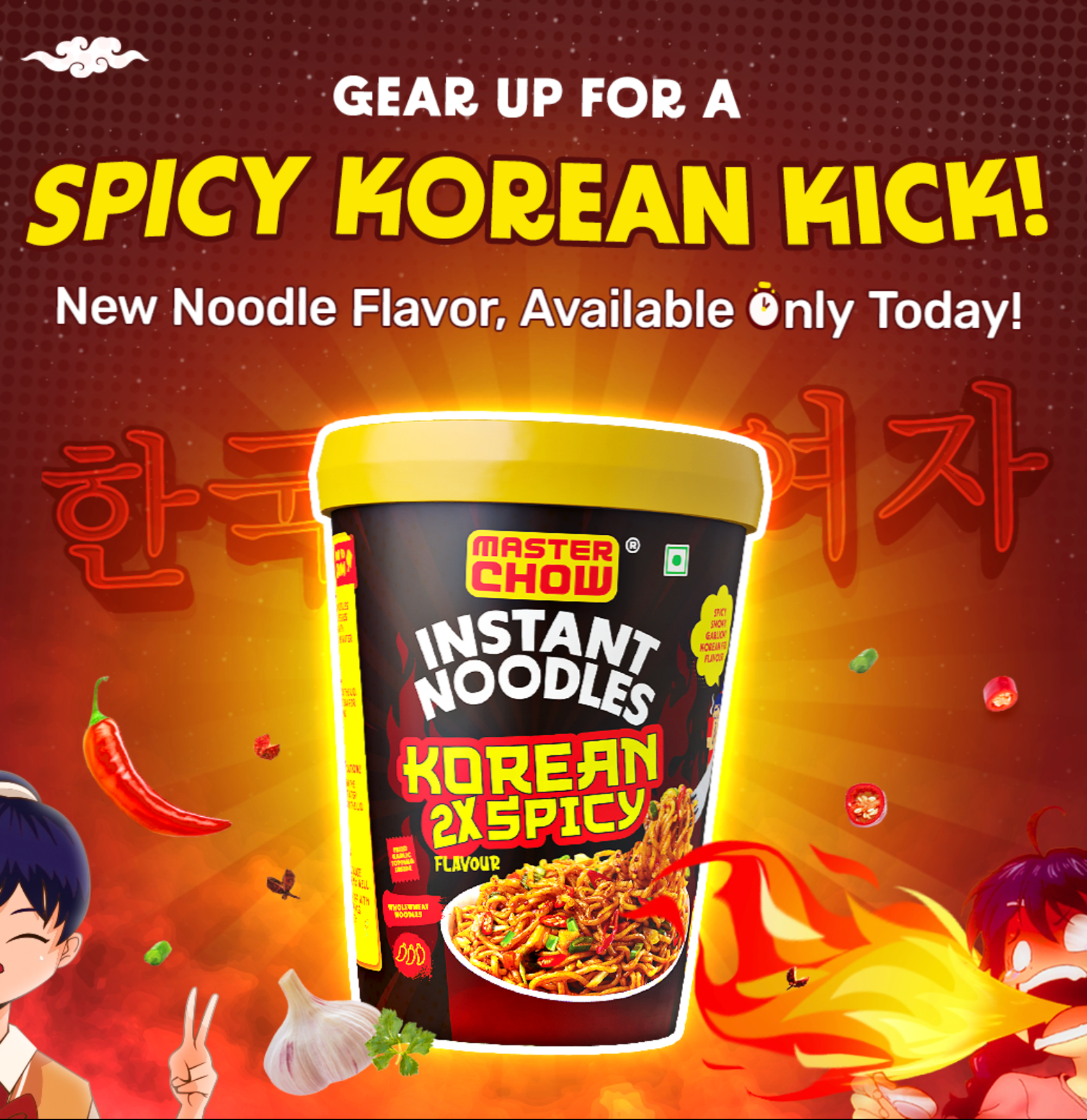
Understanding the Ad Image:
The ad features the MasterChow Instant Noodles "Korean 2X Spicy" flavor. It employs a vibrant color palette with red and yellow dominating, representing the spiciness and Asian culinary influence. The typography is bold, the graphics are dynamic, and the overall energy is high, aiming to capture the product's intensity and flavor.
Changes that can be done:
- Soften the red background to a less saturated hue to reduce visual intensity.
- Introduce some neutral colors to balance the vibrancy and add contemporary appeal.
- Simplify the graphic elements to focus on the product rather than the animated character and flames.
- Opt for a cleaner typeface for the tagline to enhance readability and modern feel.
- Scale back the number of visual elements to avoid overwhelming the viewer and maintain a contemporary aesthetic.
Sample revised image: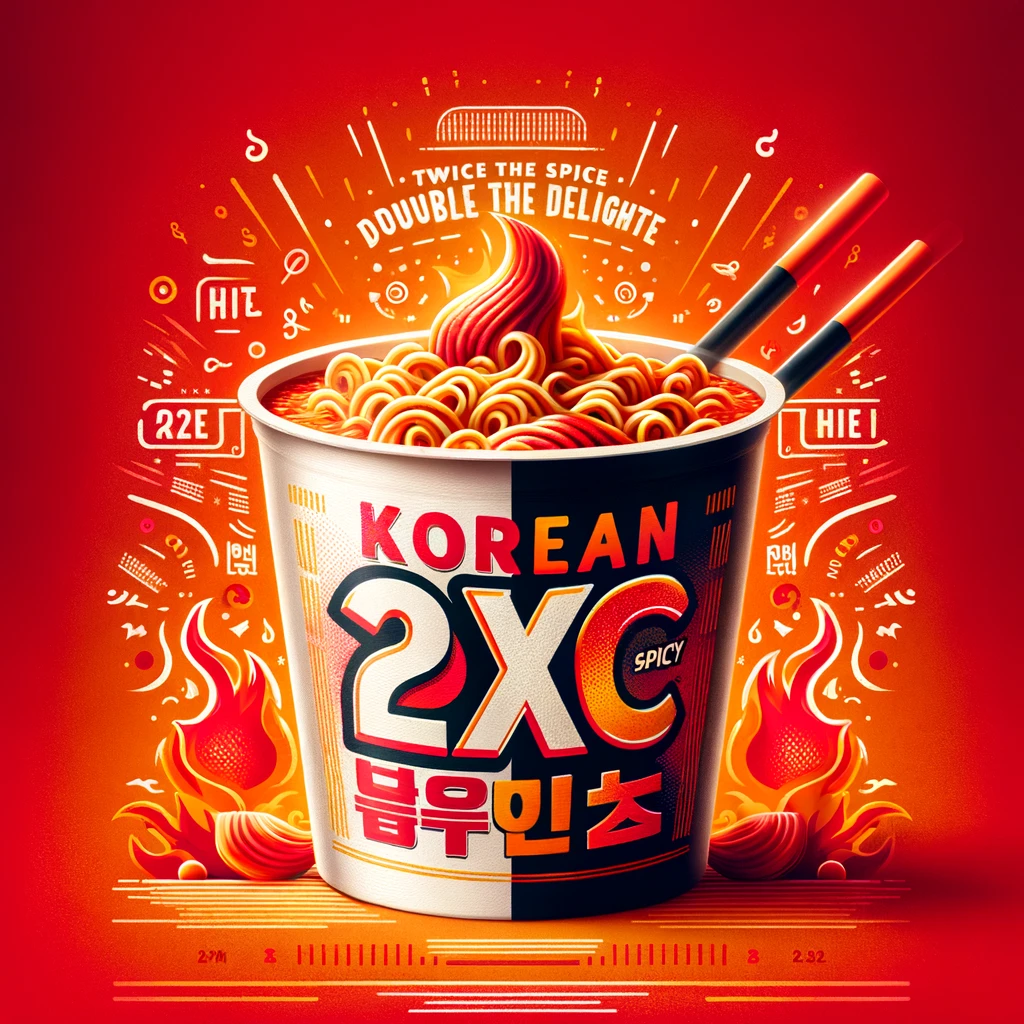
vibrant and lively, capturing the essence of the product's spicy flavor, without being too intense or overwhelming
Reasoning adhering to guidelines:
The suggested changes aim to align the ad with MasterChow’s brand look of being "vibrant and contemporary" yet "not overwhelming". By adjusting the color intensity and simplifying graphics, the ad will become more inviting and less visually cluttered, enhancing approachability without sacrificing the brand’s energetic identity. These alterations will help position MasterChow as a premium, accessible brand that respects the balance between excitement in flavors and modern, sophisticated presentation.
Applying the brand footprint to behaviour with users
1. Privacy Policy:
- Before: "We collect a variety of personal information."
- After: "We only collect essential information, with clear explanations for its use."
- Reasoning: Emphasises a user-centric approach by collecting only necessary data and being transparent, reflecting approachability without being casual.
2. Refund Policy:
- Before: "Refunds are processed within a certain number of days."
- After: "We ensure a swift refund process and provide regular updates."
- Reasoning: Shows an approachable stance by prioritizing customer convenience and keeping them informed, demonstrating a non-casual commitment to customer satisfaction.
3. Spam Policy:
- Before: "We might send promotional emails."
- After: "You have full control over the communications you receive from us."
- Reasoning: This change underlines the brand’s user-centricity by giving customers choice, making the brand approachable but not casual.
4. Data Retention Policy:
- Before: "We store personal data for indefinite periods."
- After: "We retain your data only as long as necessary and keep you informed."
- Reasoning: Balances being user-centric and approachable by ensuring customers that their data isn't held casually, with professional standards of data management.
5. User Interface Policy:
- Before: "Our platforms are designed for efficiency."
- After: "Our platforms are designed with your experience in mind, intuitive and user-friendly."
- Reasoning: Reflects approachability and user-centric design without sacrificing the professionalism of the interface.
References
- https://masterchow.in/
- https://inc42.com/lists/fast42/masterchow/?s=masterchow#inc-search-popup
- https://inc42.com/startups/30-startups-to-watch-startups-that-caught-our-eye-in-october-2022/
- https://www.socialsamosa.com/2021/12/masterchow-social-media-strategy/
- https://www.youtube.com/watch?v=WMLj1OIOJmk
- https://mehrotraproductions.com/
- https://theimageconnect.com/newsbagdetails?cname=advertising-branding&bid=4551536
- https://yourstory.com/2022/05/holy-basil-sauces-udon-noodles-fb-entrepreneurs-pan-asian-cooking-masterchow
Brand focused courses
Great brands aren't built on clicks. They're built on trust. Craft narratives that resonate, campaigns that stand out, and brands that last.
All courses
Master every lever of growth — from acquisition to retention, data to events. Pick a course, go deep, and apply it to your business right away.
Explore courses by GrowthX
Built by Leaders From Amazon, CRED, Zepto, Hindustan Unilever, Flipkart, paytm & more
Course
Advanced Growth Strategy
Core principles to distribution, user onboarding, retention & monetisation.
58 modules
21 hours
Course
Go to Market
Learn to implement lean, balanced & all out GTM strategies while getting stakeholder buy-in.
17 modules
1 hour
Course
Brand Led Growth
Design your brand wedge & implement it across every customer touchpoint.
15 modules
2 hours
Course
Event Led Growth
Design an end to end strategy to create events that drive revenue growth.
48 modules
1 hour
Course
Growth Model Design
Learn how to break down your North Star metric into actionable input levers and prioritise them.
9 modules
1 hour
Course
Building Growth Teams
Learn how to design your team blueprint, attract, hire & retain great talent
24 modules
1 hour
Course
Data Led Growth
Learn the science of RCA & experimentation design to drive real revenue impact.
12 modules
2 hours
Course
Email marketing
Learn how to set up email as a channel and build the 0 → 1 strategy for email marketing
12 modules
1 hour
Course
Partnership Led Growth
Design product integrations & channel partnerships to drive revenue impact.
27 modules
1 hour
Course
Tech for Growth
Learn to ship better products with engineering & take informed trade-offs.
14 modules
2 hours
Crack a new job or a promotion with ELEVATE
Designed for mid-senior & leadership roles across growth, product, marketing, strategy & business
Learning Resources
Browse 500+ case studies, articles & resources the learning resources that you won't find on the internet.
Patience—you’re about to be impressed.











